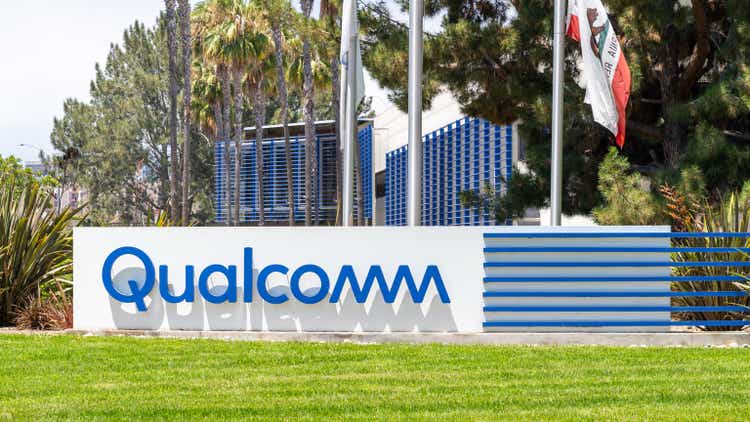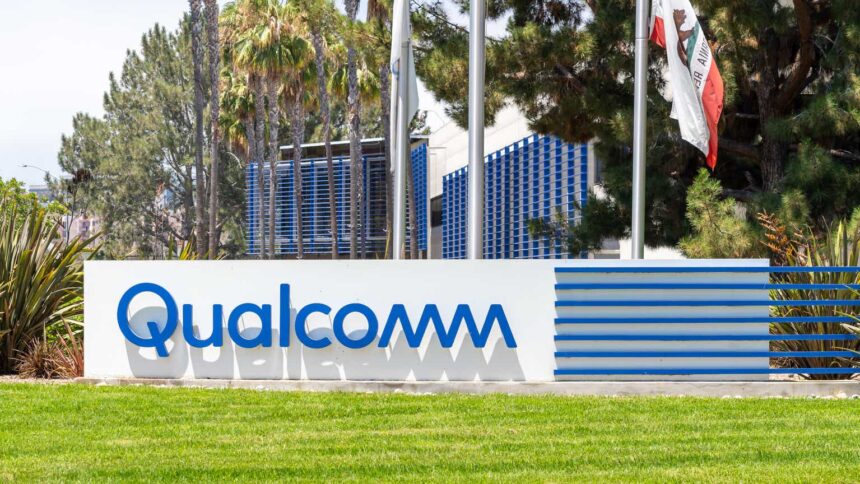JHVEPhoto
Investment Thesis
I believe that Qualcomm’s (NASDAQ:QCOM) recent advancements in on-device AI chip functionality are a game changer. With their deep integration into the supply chains of major smartphone manufacturers and a growing demand for AI-capable devices, the company is poised to capitalize extensively on upcoming tech trends.
In particular, smartphones with AI capabilities will change personalization, efficiency, and utility, and will drive consumer demand for upgrades and new purchases. Qualcomm’s recent financial disclosures demonstrate these changes, highlighting a surge in demand for their AI chips, particularly in the Chinese market, where consumers are increasingly favoring high-end devices with AI functionality.
Despite concerns regarding the U.S. chip ban impacting Qualcomm’s business in China, these fears appear overstated, in my opinion. Qualcomm’s exposure to the Chinese market, while significant, is diversified across multiple manufacturers and not solely dependent on any single entity like Huawei, which has already been significantly impacted by U.S. sanctions. Moreover, the company’s recent performance indicates that the overall growth in the sector, driven by the shift towards premium, AI-powered smartphones, more than compensates for any potential setbacks from specific regulatory actions.
Therefore, considering Qualcomm’s position in the supply chains of the world’s leading smartphone manufacturers, their proven track record in innovation, particularly in AI and 5G technologies, and the ongoing global shift towards more advanced consumer electronics, I believe the stock presents a compelling strong buy. The anticipated massive upgrade cycle for new AI smartphones is expected to significantly boost Qualcomm’s business, which will overshadow any potential risks from geopolitical tensions with China.
Background
Qualcomm’s Snapdragon 8 Gen 3 Mobile Platform enables smartphones to support up to 10 billion parameters of generative AI models solely on-device and transform them into intelligent personal assistants, according to the company.
There are a lot of reasons why they can sustain their industry leadership. Incorporating AI capabilities like natural language processing and multimodal AI that integrates vision, text, and speech are rapidly changing user interactions with their smartphones. Qualcomm’s mobile platform offers extensive support for various large language models, so devices can handle advanced tasks such as hyper-realistic gaming. It also addresses privacy and security concerns by minimizing reliance on cloud-based solutions by keeping data local to also reduce latency in AI functionalities. This is highly needed in applications requiring immediate feedback, such as real-time language translation or decision-making aids.
I think that Qualcomm’s shift towards AI-powered chips is timely. Despite previous market slumps, the company’s stock has seen a resurgence, thanks to their innovations in AI chip technology. This puts Qualcomm at the “AI edge,” a market segment focusing on leveraging AI at the device level rather than through centralized cloud infrastructures. It’s a solid path to meet future tech trends, in my opinion.
With this, there are also a lot of planned collaborations taking place. Many major smartphone original equipment manufacturers (“OEMs”) such as Honor, iQOO, realme, Redmi, and Xiaomi have reportedly sealed partnerships to expand the reach of Qualcomm’s AI chips on a wider range of consumer devices.
I have observed that the development and deployment of AI chips are becoming more crucial in a variety of applications, from mobile devices to automotive systems to handle complex AI tasks. Voice recognition and computational photography with greater speed and lower energy consumption are just some of the areas that have evolved through AI. The industry’s shift towards these specialized processors show how we’re moving away from traditional CPU-centric architectures in favor of more versatile, purpose-built platforms.
What Makes These Chips Unique
Qualcomm’s new generation of AI chips, the Snapdragon 8 Gen 3 and 8s Gen 3 platforms, are pioneering the smartphone industry by handling a maximum of 10 billion parameters for generative AI models directly on the mobile device. These chips allow for real-time, complex AI tasks such as natural language understanding and multimodal interactions without needing to connect to the cloud by integrating large language models like LLaMA 3 and Baichuan-7B directly into the device. The company claims that this can also ensure user privacy and data security by keeping sensitive inputs and interactions local.
They also feature always-sensing ISP, hyper-realistic mobile gaming, and breakthrough connectivity enhancements for enhanced multimedia experiences and superior connectivity solutions and more reliable internet access.
These AI chips are engineered with Qualcomm’s Hexagon NPU and can offer up to 98% faster processing with 40% reduced power consumption. This is particularly useful in mobile environments where power conservation is highly needed. The AI Engine’s ability to perform tasks such as real-time voice translation and complex image processing locally further underscores their utility in a world where edge computing is becoming increasingly important.
Qualcomm’s AI chips are also capable of optimizing specific calculations required by advanced AI models, which are increasingly vital as applications like live language translation and real-time content generation have now become common. The chips can execute large numbers of parallel computations to enable more efficient processing given the energy constraints of mobile devices.
I have also noticed that the chips are strategically priced to bring premium features to more affordable smartphone models, so this will definitely expand the public’s accessibility of advanced AI capabilities.
Agreement with Apple
Apple has renewed their contracts with Qualcomm, ensuring that it has the necessary components to support their future smartphone releases while continuing to develop their technology. The multi-year deal involves supplying Snapdragon 5G Modem-RF Systems to Apple’s smartphones through 2026. It marks an unexpected halt in Apple’s push towards self-reliance in modem technology. It goes to show that despite Apple’s vast resources and engineering prowess, it still cannot match the complexity of creating modem chips that perform on par with Qualcomm’s products.
Qualcomm’s expertise and specialized technology are not easily replicated. Modem chips, particularly those that support advanced network standards like 5G, require only deep technical knowledge and experience, as well as extensive testing and certification across global markets. As such, companies that are increasingly looking to control more of their supply chain may find it difficult to do so at this time.
What Is The TAM Of This?
While the TAM (Total Addressable Market) can’t be precisely estimated. Management has provided clues indicating they think there is strong upside.
For example, at the Bernstein Conference:
There’s something that is different now, especially when the Microsoft Copilot, the Microsoft revenue model for the Copilot, Microsoft is driving a transition of the enterprise to Windows 11 to AI PCs, that is helping us having a bigger addressable market first. And even if you model, like, we have 10% share, it’s a significant, I think, upside for Qualcomm. -Bernstein Conference.
The overall PC market is set to grow to $270 billion annually by 2028. By 2028, an estimated 205 million of these PCs will be AI enabled. With an estimated 10% market share as positioned by Qualcomm’s management, This would equal out to 20.5 million PCs with Qualcomm chips in them alone (not including smartphone chips). Given their latest AI chip, the Snapdragon 8 could cost $200/each, this could mean $4.1 billion annually just in AI PC chip revenue. This does not include AI smartphone chip revenue as well.
Given that PCs are just a part of their $1.2 billion quarterly revenue from IoT division (and now just PCs in here could be over $4.1 billion annually) there could be room for strong growth.
Given that the ratio of smartphone to IoT chip revenue is currently about 1:5, we could see over $20 billion annually in AI smartphone chip revenue using this approximation.
Valuation
Despite the forward-looking growth estimates for AI-driven smartphone technology, Qualcomm’s forward non-GAAP Price-to-Earnings (P/E) ratio stands at 20.85, which is slightly below the sector median of 23.77. This represents a discount to the sector median of 12.28%.
This gap in valuation, particularly in the context of Qualcomm’s strategic pivot towards AI chipsets for mobile devices, I believe suggests that the market is undervaluing the company’s potential revenue growth. Qualcomm is slowly transitioning with a new focus, as highlighted in their recent keynote presentation, look promising. Cristiano Amon, Qualcomm’s CEO, emphasized in the event:
Qualcomm is changing into a communications company, into a connected computing company and now bringing really intelligence everywhere. It is great. Exactly flattering for Qualcomm to come to this new space and prove ourselves as a leader in compute and see all the competitors now benchmarking themselves against Qualcomm. That’s kind of incredible really, for us. -Computex 2024 Keynote
Considering Qualcomm’s role in pioneering AI integration into smartphones, the conservative forward growth estimates might not fully account for the potential surge in demand since these technologies become mainstream. If Qualcomm’s forward non-GAAP P/E ratio were adjusted from 20.85 to align with the sector median of 23.77, this would imply an approximate 14% increase in stock price, assuming earnings projections remain constant.
I think this will be possible with the further progress of AI and the company’s collaborations. CEO Amon explained:
I think the AR has potential to gain scale. I’m actually very happy about what we’re seeing right now with the project we have with Meta, the Ray Ban glasses, there are other devices coming, that’s in the IoT segment.
The other thing that is in the IoT segment is our Wi-Fi access point business. Retail, enterprise, carrier gateway has been one that is growing. Most people don’t know this, but we actually also develop our own fiber asset. We have XG-PON and we’ve been growing the carrier segment as well for Wi-Fi access point. Also in that, it’s our wearable business, our industrial business. -Bernstein’s 40th Annual Strategic Decisions Conference
Risks
The revocation of licenses by the Biden Administration for Qualcomm (QCOM) and Intel (INTC) for exporting semiconductors to Huawei has further heightened the trade restrictions between the U.S. and China. This has also impacted the planning of semiconductor companies that are heavily invested in the Chinese market. Qualcomm, for instance, has seen a 40% increase in sales to Chinese smartphone makers in the first half of their fiscal year, underscoring the importance of this market to their revenue stream.
The geopolitical tension highlights a broader risk of dependence on single markets, particularly when that market is at the center of significant political and economic disputes with the U.S. government. The U.S. has been tightening their export controls, particularly targeting companies like Huawei, over technological leadership and national security. The recent policy changes are aimed at curtailing China’s ability to acquire advanced technologies for telecommunications and artificial intelligence.
For Qualcomm, the stakes may be high. The company’s significant exposure to the Chinese market—where it has capitalized on the burgeoning demand for AI-enabled smartphones—means any disruption due to export bans could have severe repercussions. The situation is further compounded by China’s retaliatory potential in trade measures, which could target American companies operating in or exporting to China.
Despite concerns regarding the U.S. chip ban impacting Qualcomm’s business in China, I still believe that these fears are overstated in my opinion. Qualcomm maintains a diversified market across multiple manufacturers and is not solely dependent on any single entity like Huawei, which has already felt the impact of U.S. sanctions. In addition I think chip demand from AI could help them accelerate growth and offset lost revenue like Nvidia (NVDA) did with their China division.
Bottom Line
I believe that Qualcomm’s AI chips have positioned the company at the forefront of a transformative phase in mobile technology. The burgeoning demand for AI-enabled devices will trigger the company’s further growth.
Despite the geopolitical tensions and the potential risks associated with the U.S. chip ban impacting their Chinese operations, these concerns are, in my view, markedly overstated. Qualcomm’s broad diversification across multiple manufacturers mitigates the risk of dependency on any single entity, such as Huawei, which has already faced challenges due to U.S. sanctions.
Qualcomm, in my view, will be one of the top earners from the anticipated massive upgrade cycle in AI smartphones globally. This upgrade cycle, driven by consumers’ increasing preference for more sophisticated, AI-powered smartphones, will influence the company to find more ways of offering their unique value.
With this, I think the stock is a strong buy.




